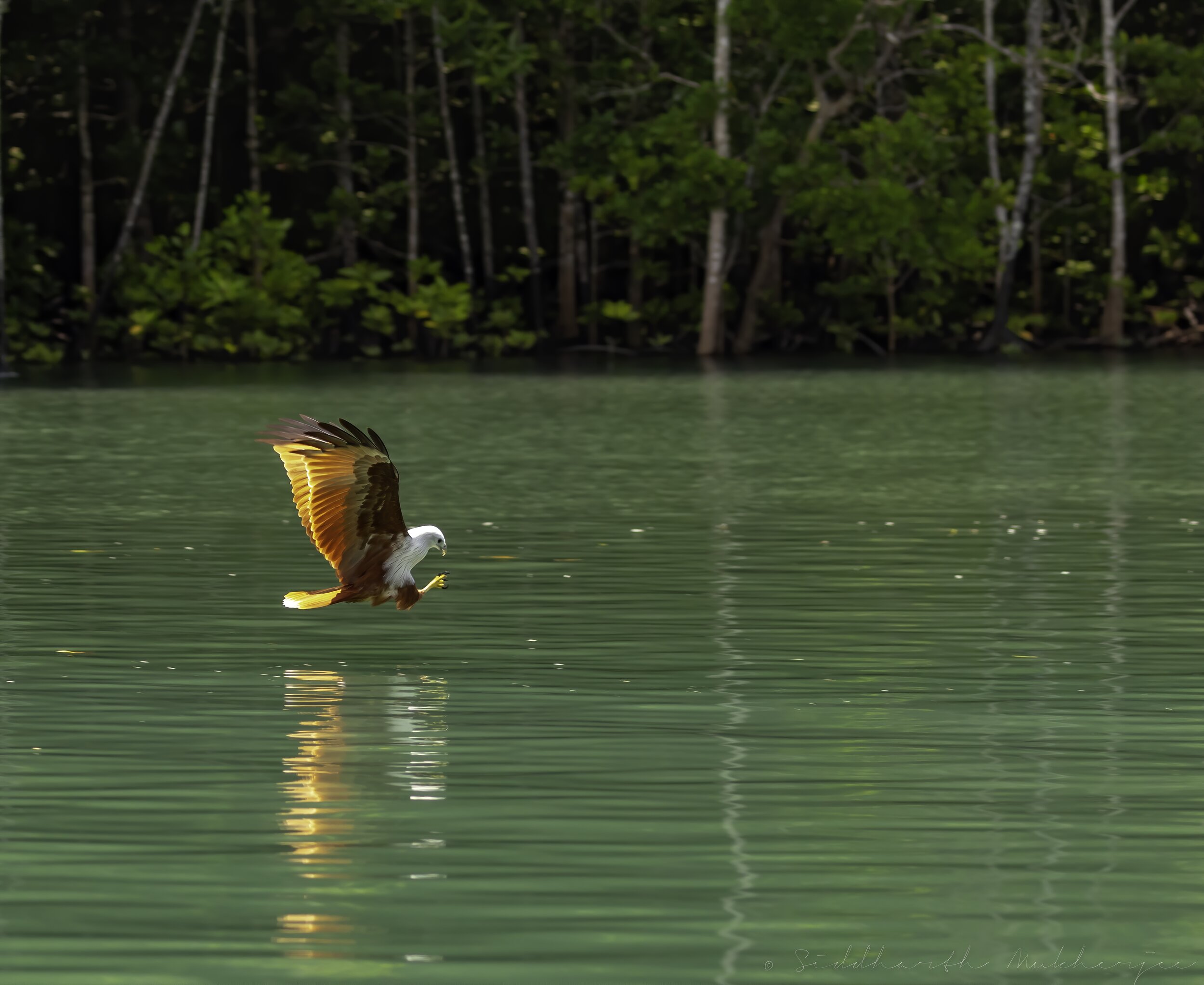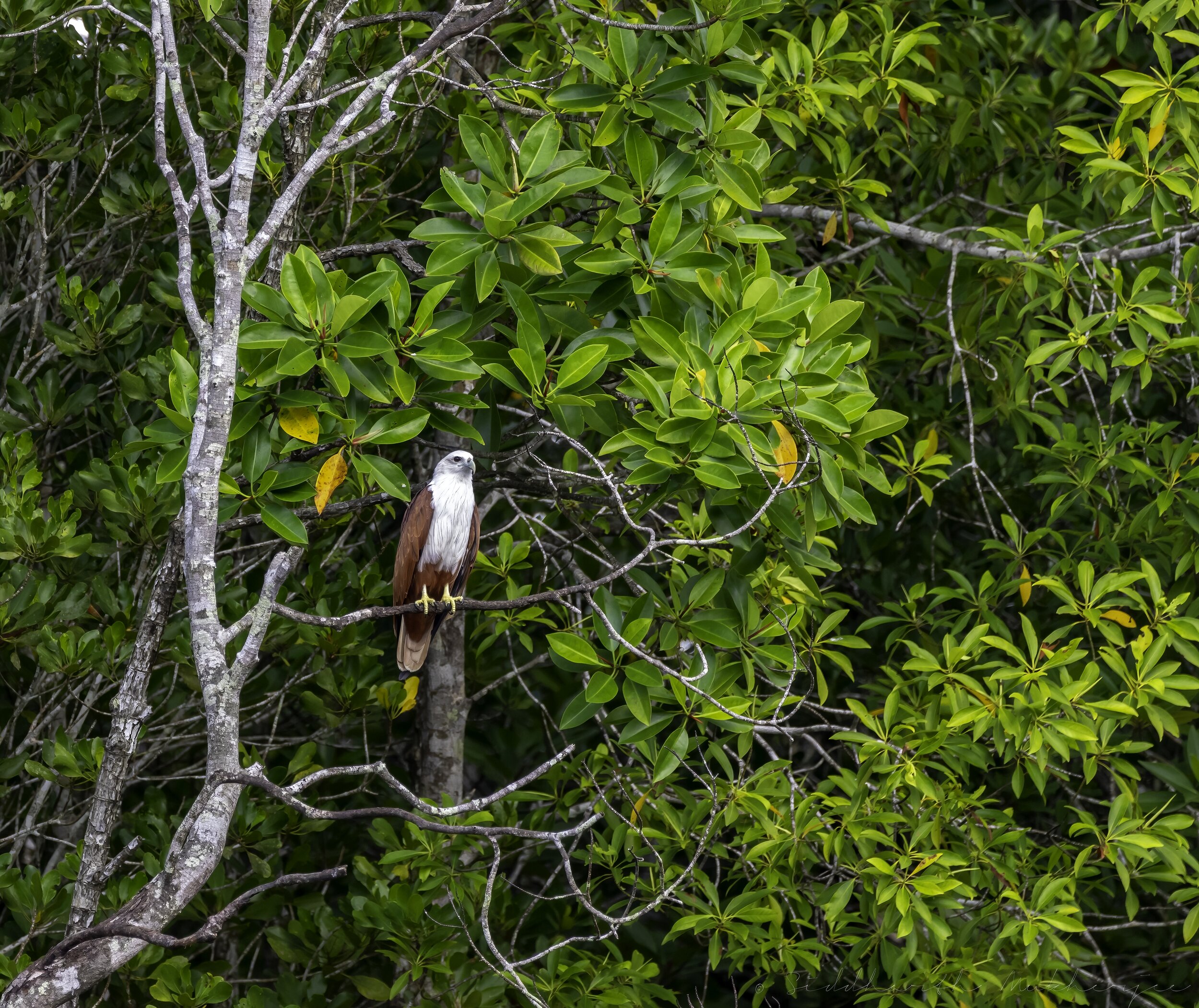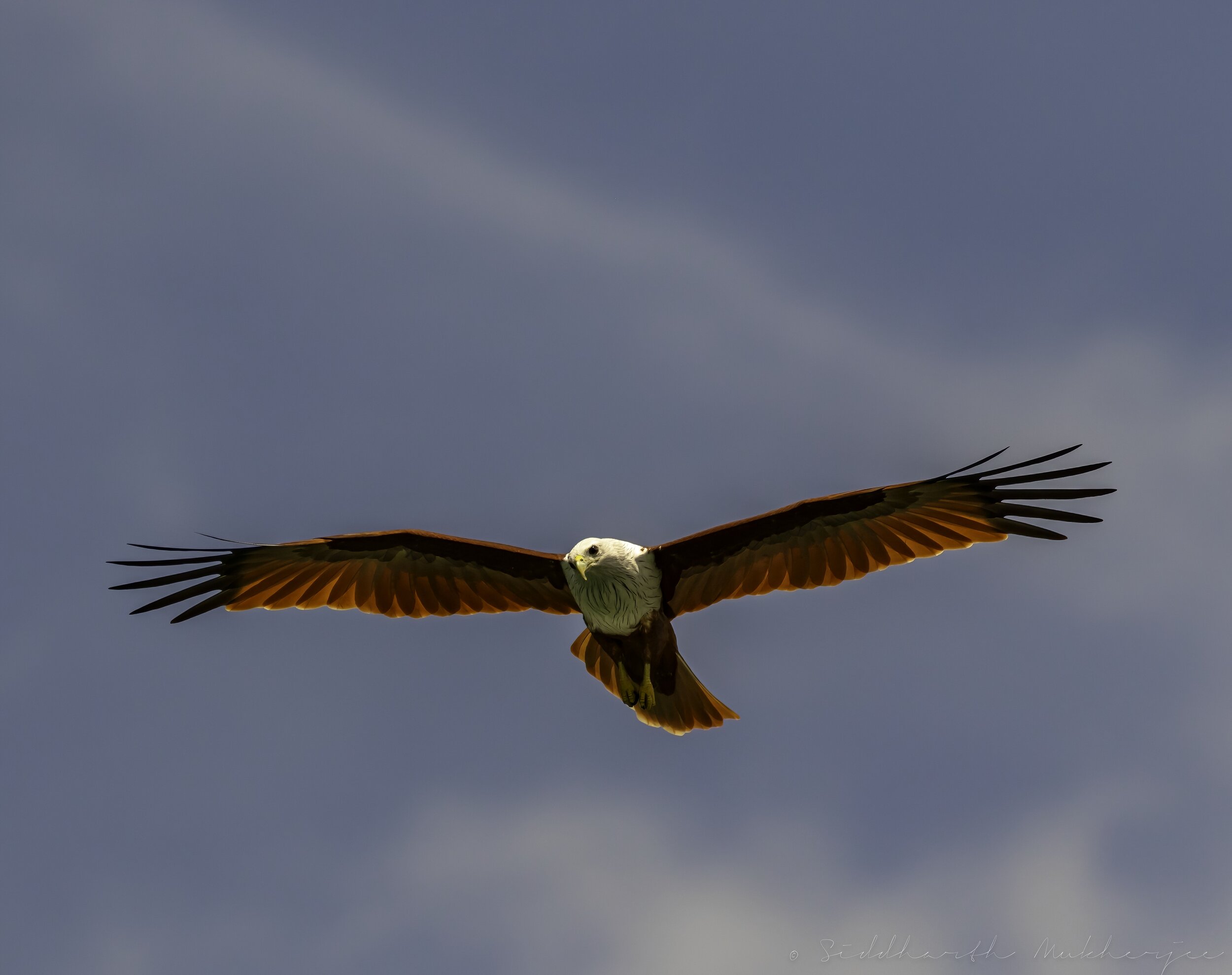Red-backed Sea Eagle/ Brahminy Kite
Haliastur indus
Langkawi, Malaysia
After our sojourn in the Dois of Chiang Mai we now make our way to the emerald waters of Langkawi in Malaysia - the jewel of Kedah.
Officially known as Langkawi, the Jewel of Kedah (in Malay: Langkawi Permata Kedah), is a district and an archipelago of 99 islands (plus five small islands visible only at low tide) in the Malacca Straits. some 30 km off the coast of northwestern Malaysia. Surrounded by turquoise sea, the interior of the main island is a mixture of picturesque paddy fields and jungle-clad hills while the shoreline is fringed by powder-fine sand, swaying coconut trees and dense mangroves. The islands are a part of the state of Kedah, which is adjacent to the Thai border; the islands are a few kilometres south of Ko Tarutao. On 15 July 2008, the then-sultan of Kedah, Abdul Halim Mu'adzam Shah, conferred the title of Langkawi Permata Kedah (meaning 'Langkawi, the Jewel of Kedah') upon the island as part of his golden jubilee as an affirmation of Kedah's ownership over the island.
The island of Langkawi was recorded in history by various travellers to the region. It was called Lóngyápútí in the 14th century by the Yuan dynasty traveller Wang Dayuan. When the Ming dynasty admiral Zheng visited the region, the island was marked as Lóngyájiāoyǐ, on his map. In the 15th century, it was known to the Acehnese as Pulau Lada ('Pepper Island'). In 1691, the French general Augustin de Beaulieu recorded going to the island of "Lancahui" (Langkawi) to buy pepper, and de Beaulieu was required to obtain a license from Kedah's heir apparent then in Perlis before the penghulu or chief of Langkawi would sell pepper to him. The name Langkawi is thought to have existed by the early 15th century, although in the 16th century the island of Langkawi was also marked on maps variously as Langa, Langka, Lansura, and Langapura. There are many suggestions for the origin of the name of Langkawi. According to one interpretation, Langkawi means island of the reddish-brown eagle, a Brahminy Kite in colloquial Malay. The Malay word for eagle is helang (colloquially shortened to lang), and kawi is a red stone used as a chalk to mark goods. This interpretation was used to create the landmark sculpture of an eagle as the symbol of Langkawi at Dataran Helang (Eagle Square) in Kuah, the largest town on the island.
Some believed that Langkawi is the same as, or related to, the Lanka or Langkapuri mentioned in the epic Ramayana as the city of King Ravana. This ancient name Lanka (or Lankapura and Lankapuri) is found in Indian literature from an early period although the identification of the original Lanka is not certain. Puri or puram in Sanskrit means a town or city. The name Langkawi is also thought to be related to Langkasuka, an old kingdom believed to have links with Kedah. Some also thought that Langkawi means "many beautiful islands", langka being a Sanskrit word meaning "beautiful" while wi means "many".
Our area of interest however, is in the northwest of the main island which is about 25 kilometres (16 mi) from north to south and slightly more from east to west. The coastal areas consist of flat, alluvial plains punctuated with limestone ridges. Two-thirds of the island is dominated by forest-covered mountains, hills, and natural vegetation. On 1 June 2007, Langkawi Island was given a World Geopark status by UNESCO. Three of its main conservation areas in Langkawi Geopark are Machincang Cambrian Geoforest Park, Kilim Karst Geoforest Park, and Dayang Bunting Marble Geoforest park (Island of the Pregnant Maiden Lake). These three parks are the most popular tourism area within Langkawi Geopark. In 2014, UNESCO issued a "yellow card" warning threatening the status of the Geopark.
The island's oldest geological formation, the Machinchang Formation, was the first part of Southeast Asia to rise from the seabed in the Cambrian more than half a billion years ago. The oldest part of the formation is observable at Teluk Datai to the northwest of the island, where the exposed outcrop consists of mainly sandstone (quartzite) in the upper parts and shale and mudstone in the lower parts of the sequence. The other known example, the Jerai Formation, emerges near the west coast of Kedah on the mainland (peninsula). Geologically, all these rocks are in the Western Belt of peninsular Malaysia, which is thought to be part of the Shan–Thai Terrane.
‡‡‡‡‡
The following photo of the Brahminy Kite was used as the background image in a label to some textile pieces created by Italian sustainable fashion designer Mariangela Cataldo to raise awareness about various locations on the planet launched at the 9th Edition of the Pause Conscious pop-up in London between 13-22 September 2019 as part of the London Fashion Week. Mariangela shared the designs on the her Instagram stream as well.
Photographed: Sept 1, 2018 | Published: Sept 13, 2019
Click on the button to view the publication.
Red-backed Sea Eagle/ Brahminy Kite
The Brahminy Kites (Haliastur indus), formerly known as the Red-backed Sea Eagle in Australia, are medium-sized raptors that are easily recognized by their white head and chest. They are also known as Red-backed Kites, White-and-red Eagle Kites or White-headed Kites. These birds of prey are widespread throughout tropical Asia.
In Indonesia, they are known as elang bondol and is the official mascot of the capital and largest city of Indonesia - Jakarta. In Hinduism, the bird is considered as the contemporary representation of Garuda, the sacred bird of Lord Vishnu - the preserver in the holy Hindu Trinity. According to a fable from central Bougainville Island, a mother left her baby under a banana tree while gardening, and the baby floated into the sky crying and transformed into Kaa'nang, the Brahminy kite, its necklace becoming the bird's feathers.
The Brahminy is a medium-sized raptor with a rounded tail unlike other kites. This kite has a sharply contrasting plumage; with a mostly bright chestnut body, except for white head, neck, throat, upper belly and flanks; a white-tipped tail and black outer flight feathers. The adults are unmistakable with a white head and breast contrasting with otherwise brick brown plumage. The Juveniles are a darker brownish-black with a paler head and prominent white patches under the wings. Usually associated with both inland and coastal wetlands in tropical Asia, but they are largely restricted to coastal wetlands in Australia where they are alternately known as “Red-backed Sea Eagle.” These magnificent raptors occur naturally on the Indian subcontinent, through southern China and south-east Asia, south into Australia as far south as New South Wales. In Australia, their range stretches across northern Australia, mainly along the coastline from Western Australia to northern New South Wales. However, they are more common in the north of its range. Within their expansive range, these birds are mostly resident, except for some seasonal movements associated with rainfall in some parts of their range.
Their call is a distinctive nasal, drawn out, “Kyeeerrh.”
They are most commonly seen sailing on level wings along shorelines, mudflats, mangrove swamps and estuaries. They are also observed in inland wetlands, flying over forests and rice paddies, and along rivers. They are usually alone; in pairs; or in small family groups. Occasionally, especially here in the isolated northeast of Langkawi, they roost in flocks on large and isolated trees; as many as 600 of them have been sighted at one location.
Brahminy kites don't migrate but perform seasonal movements associated with rainfall in some parts of their range. They are usually seen alone or in pairs and may roost communally on large and isolated trees. Brahminy kites hunt by day soaring high in the air looking for prey. They may also hunt from a perch, or on the ground. They may also indulge in kleptoparasitism and try to steal prey from other birds. Brahminy kites have even been recorded taking advantage of Irrawaddy dolphins herding fish to the surface. These birds are generally silent, however, when they need to communicate with each other, they utter a mewing 'keeyew' call or a lamb-like 'pee-ah-ah-ah'.
Brahminy kites are carnivores and opportunistic scavengers. They are primarily scavengers and feed mainly on dead fish and crabs, especially in wetlands and marshland, but occasionally hunt live prey such as hares, bats, and flying insects. They will eat just about anything, including food waste (from boats and rubbish dumps); carrion (dead animals), such as dead fish; and crabs. Their diet varies considerably between different populations and is influenced by what is readily available in their habitat. They forage by flying low above the ground or over water and snatch live prey or carrion from the surface - a behaviour best seen in Langkawi. They also hunt from a waterside perch and capture prey in flight. They may also feed on the ground.
Interesting Behaviour
I’ve seen immature birds indulging in playful behaviour, such as dropping leaves and attempting to catch them in the air, chasing each other over the mangroves and water. When fishing over water, they may sometimes land in the water but manage to swim and take off without much trouble. They are known to mob larger raptors, such as the much larger Steppe Eagles (Aquila nipalensis); and steal prey from fish-hunting birds like the White-bellied Sea Eagle also seen at the same location in Langkawi and in the Sungei Buloh Wetlands in Singapore. I will write about the magnificent White-bellied Sea Eagles in a future blog. The Brahminy Kites have also been recorded taking advantage of Irrawaddy dolphins as they herd fish to the surface. In one instance, one Brahminy Kite has been reported to feed on the honey at the hive of Dwarf Honey Bees (Apis florea) - reported on www.archive.org
Brahminy kites are not considered globally threatened at present. However, their populations are declining due to hunting and collection of nestlings, disturbances, over-use of pesticides, and habitat loss. According to the IUCN Red List, the total Brahminy kite population size is more than 100,000 individuals. Currently, this species is classified as Least Concern (LC) on the IUCN Red List but its numbers today are decreasing.
‡‡‡‡‡
I took a series of these flight panoramic photos with the 7D Mark 2 to try and recreate the action and also capture more of the location and the ambient conditions at the time. All of these photos from Langkawi are from a boat and some, like the one below, in the rain.
‡‡‡‡‡
Related Posts

























